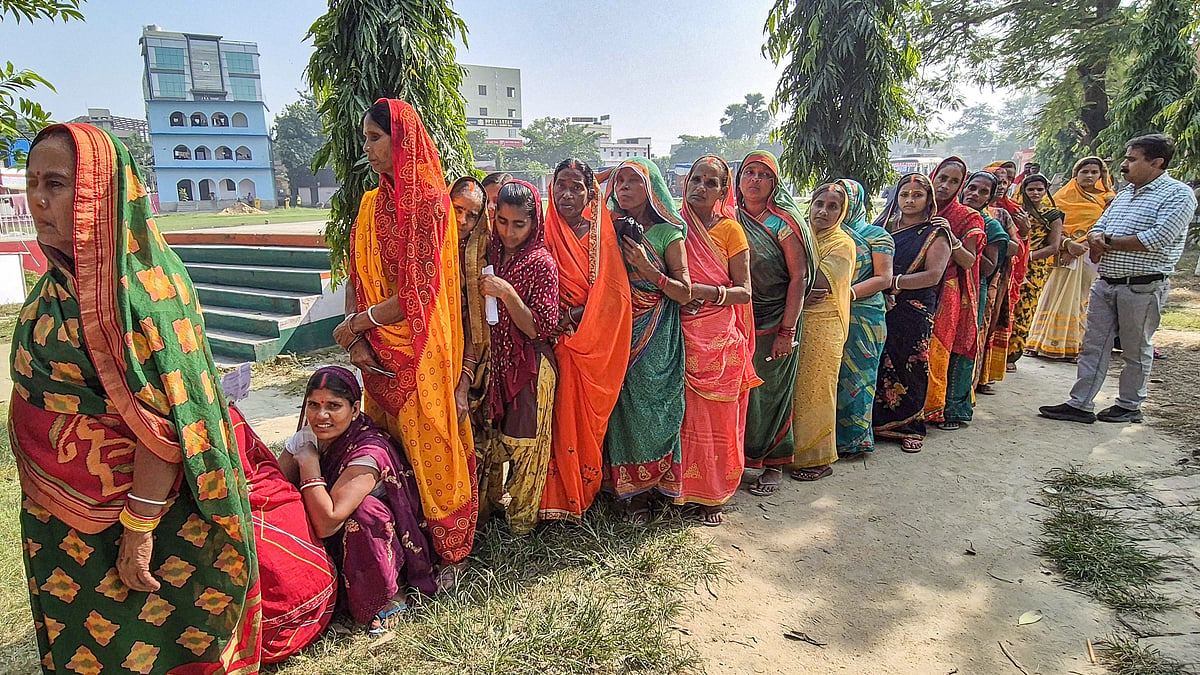POLITICS
Bihar polls: Stray violence, irregularities mark first phase
Begusarai records highest turnout at 67.32 per cent, followed by Samastipur (66.65 per cent) and Madhepura (65.74 per cent)

Amid stray incidents of violence and reports of voter intimidation, Bihar’s first phase of Assembly elections on Thursday witnessed 60.18 per cent voter turnout by 5.00 pm, according to the Election Commission of India (ECI). Over 3.75 crore voters were eligible across 121 Assembly segments spread over 18 districts, with Begusarai recording the highest turnout at 67.32 per cent, followed by Samastipur (66.65 per cent) and Madhepura (65.74 per cent).
While polling was largely peaceful in most areas, the day was punctuated by tension and accusations from both sides. Deputy chief minister Vijay Kumar Sinha’s convoy was attacked in Lakhisarai, with slippers hurled at his vehicle — an incident that the BJP called evidence of Opposition “lawlessness”.
However, Bihar Police ADG (HQ) cum SNPO Kundan Krishnan later said, "In Khuriari village, Lakhisarai, deputy CM Vijay Kumar Sinha faced protests from villagers. They stated that the roads were damaged and there was mud, and there are also allegations that mud was thrown at him. A scuffle also took place. However, the DM and SP reached the spot immediately and escorted the deputy CM from the scene..."
The RJD, meanwhile, accused police and ruling-party supporters of voter intimidation and violence at multiple polling booths, circulating videos purporting to show officers roughing up voters. In several constituencies, polling was briefly disrupted owing to EVM malfunctions, power outages and booth scuffles, prompting Opposition complaints of a deliberate slowdown in INDIA bloc strongholds. The ECI later said voting had proceeded “smoothly overall”, promising investigation into “isolated incidents”.
Published: undefined
The first phase set the tone for an intense contest between the ruling NDA, led by chief minister Nitish Kumar, and the Opposition INDIA bloc spearheaded by Tejashwi Yadav. The NDA, in power for nearly two decades barring a brief interlude, has once again leaned on its sushasan (good governance) plank — contrasting it with what it terms the “jungle raj” of the RJD-Congress years in the 1990s.
But the Opposition has sought to turn that charge around, pointing out that Bihar’s law-and-order situation has barely improved in 20 years under NDA governments. Reports of rising crimes against women, political killings, custodial deaths and rural insecurity have punctured the BJP-JD(U)’s claim of good governance. Critics note that despite welfare measures and cash transfers, the social anxieties once blamed on Lalu’s regime now persist under Nitish’s watch.
Prime Minister Narendra Modi, campaigning in constituencies going to polls in the second and final phase on 11 November, hailed the high turnout of women as a sign of NDA support. “Mothers, daughters and sisters have been the worst sufferers of jungle raj. Today, they have formed a fortress around polling booths to stop its return,” he said.
The NDA hopes Nitish Kumar’s welfare record — including 125 units of free electricity, Rs 10,000 transfers to over one crore women, and enhanced social-security pensions — will counter anti-incumbency.
Published: undefined
RJD president Lalu Prasad Yadav struck a chord online with his earthy metaphor in a social media post: “If a roti is not flipped on the tawa, it burns. Twenty years is a long time. A Tejashwi government is essential to build a new Bihar.”
His message has resonated strongly with younger and rural voters, weary of the same leadership and disillusioned with unfulfilled promises of jobs and reform. Tejashwi Yadav’s campaign — centred on employment, dignity and a generational shift — has attempted to recast the RJD as the alternative to an establishment grown complacent.
Adding intrigue to the mix is Prashant Kishor’s Jan Suraaj Party, whose rallies have drawn large crowds despite his decision not to contest. Kishor’s vow to make Bihar “one of India’s top-performing states” — and his pledge to scrap the prohibition law, which he calls a “moral farce that has bankrupted the state and emboldened the liquor mafia” — has opened a new flank in the political debate. His real impact, analysts say, may lie in fracturing the anti-NDA vote.
While rural enthusiasm remained high, urban participation lagged behind, with Patna recording just 48.69 per cent turnout. Constituencies such as Bankipur (34.80 per cent), Digha (31.89 per cent) and Kumhrar (37.73 per cent) remained stubbornly low — a recurring trend in Bihar’s urban elections.
As the state heads into the second phase, the question is no longer only whether Nitish Kumar’s NDA can hold power — but whether Bihar’s democratic machinery, after 20 years of the same stewardship, still commands the people’s trust.
With PTI inputs
Published: undefined
Follow us on: Facebook, Twitter, Google News, Instagram
Join our official telegram channel (@nationalherald) and stay updated with the latest headlines
Published: undefined